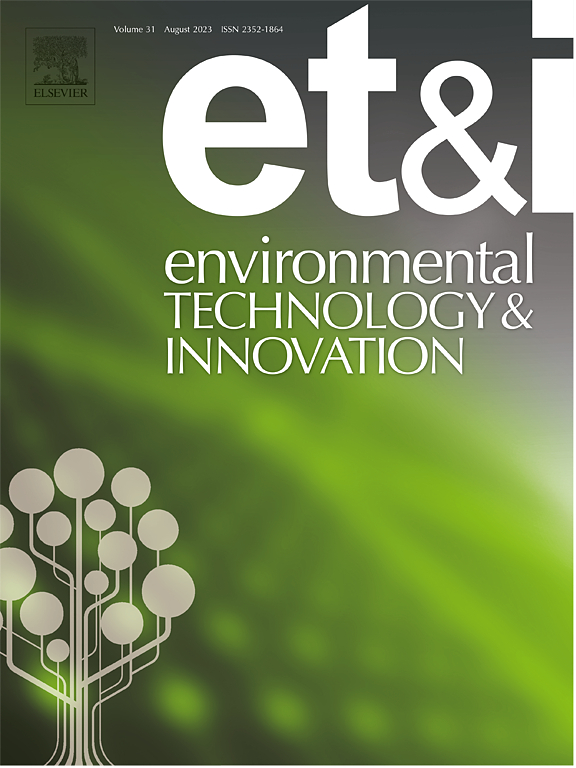Recovery phosphorus and water resources from corn deep-processing wastewater using a combined process of forward osmosis and hydroxyapatite
IF 6.7
2区 环境科学与生态学
Q1 BIOTECHNOLOGY & APPLIED MICROBIOLOGY
引用次数: 0
Abstract
The global scarcity of phosphorus and water resources has become a pressing environmental issue, prompting extensive research into resource recovery strategies. Wastewater generated from corn starch processing exhibits high chemical oxygen demand (COD) and elevated concentrations of nitrogen and phosphorus, and is typically treated using combined anaerobic-aerobic processes. However, effluent from secondary biological treatment still contains considerable phosphorus, with PO43--P concentrations exceeding 70 mg/L. Consequently, implementing water and phosphorus recovery processes as an alternative to conventional chemical removal methods aligns with circular economy principles and supports sustainable development goals. This study investigated the feasibility of recovering phosphorus and water from the effluent of secondary sedimentation tanks in corn starch processing wastewater using a forward osmosis-hydroxyapatite (FO-HAP) combined process and optimized the operational parameters. In the FO unit, the phosphorus concentration increased 5.9-fold compared to the feed water, reaching a PO43--P level of 210.2 mg/L, with a water recovery rate of 80 %. In the HAP-induced crystallization unit, phosphorus removal efficiency reached 98 %, and the purity of the synthesized HAP was 75 % under optimal conditions (stirring intensity of 200 rpm, pH of 10, Ca/P molar ratio of 3). Overall, the FO-HAP combined process provides an effective approach for recovering phosphorus and water from secondary effluent in corn starch processing, offering both a practical technical solution and a theoretical basis for wastewater treatment and resource utilization in the industry.
正渗透-羟基磷灰石联合工艺回收玉米深加工废水中的磷和水资源
全球磷和水资源的短缺已成为一个紧迫的环境问题,促使人们对资源恢复策略进行了广泛的研究。玉米淀粉加工产生的废水具有高化学需氧量(COD)和氮、磷浓度升高的特点,通常采用厌氧-好氧联合工艺处理。然而,二级生物处理出水仍含有大量磷,PO43—P浓度超过70 mg/L。因此,实施水和磷回收工艺作为传统化学去除方法的替代方案符合循环经济原则,并支持可持续发展目标。研究了正渗透-羟基磷灰石(FO-HAP)组合工艺回收玉米淀粉加工废水二沉池出水磷和水的可行性,并对操作参数进行了优化。在FO装置中,磷浓度比给水提高了5.9倍,PO43—P水平达到210.2 mg/L,水回收率为80% %。在HAP诱导结晶单元中,在搅拌强度为200 rpm、pH为10、Ca/P摩尔比为3的最佳条件下,HAP的除磷效率可达98 %,合成HAP的纯度可达75 %。综上所述,FO-HAP联合工艺为玉米淀粉加工二次出水磷和水的回收提供了一条有效途径,为工业废水处理和资源化利用提供了切实可行的技术解决方案和理论依据。
本文章由计算机程序翻译,如有差异,请以英文原文为准。
求助全文
约1分钟内获得全文
求助全文
来源期刊

Environmental Technology & Innovation
Environmental Science-General Environmental Science
CiteScore
14.00
自引率
4.20%
发文量
435
审稿时长
74 days
期刊介绍:
Environmental Technology & Innovation adopts a challenge-oriented approach to solutions by integrating natural sciences to promote a sustainable future. The journal aims to foster the creation and development of innovative products, technologies, and ideas that enhance the environment, with impacts across soil, air, water, and food in rural and urban areas.
As a platform for disseminating scientific evidence for environmental protection and sustainable development, the journal emphasizes fundamental science, methodologies, tools, techniques, and policy considerations. It emphasizes the importance of science and technology in environmental benefits, including smarter, cleaner technologies for environmental protection, more efficient resource processing methods, and the evidence supporting their effectiveness.
 求助内容:
求助内容: 应助结果提醒方式:
应助结果提醒方式:


